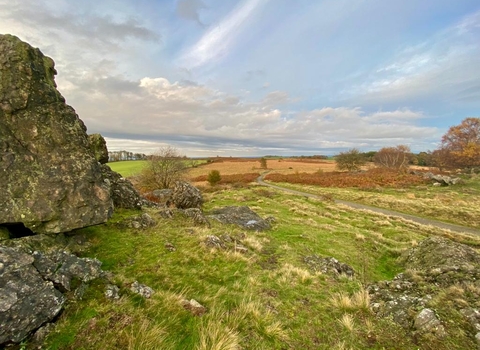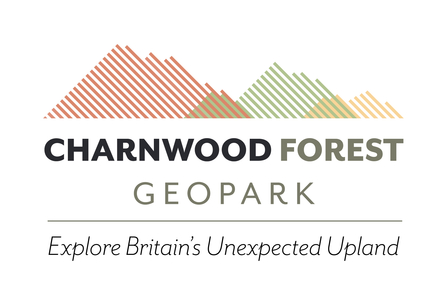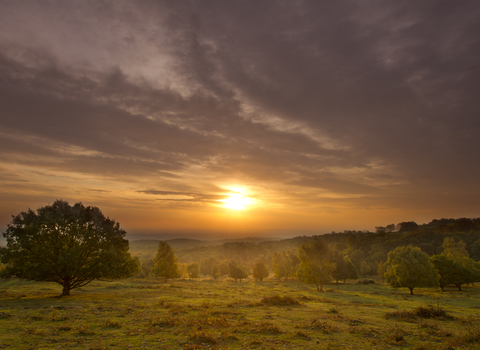Working to preserve and enhance the landscape of the Charnwood Forest
The unique landscape of the Charnwood Forest is one of the most significant in the East Midlands, but very few people are aware of its value, both locally and internationally. The landscape is currently at risk and the Charnwood Forest Landscape Partnership Scheme will create new projects to protect and enhance it, made possible thanks to funding from the National Lottery Heritage Fund.
This five year scheme will promote awareness and understanding of the importance of Charnwood Forest through geological conservation, habitat restoration, improvements to connections between sites for visitors, creating innovative interpretation, outdoor learning opportunities for young people and adults, and a five-year programme of cultural and heritage activities and events.

The Charnwood Forest
Charnwood Forest’s rocky outcrops, some of the oldest rocks on the planet, were thrown up by volcanic activity in the southern oceans more than 600 million years ago. Millions of years of global plate tectonic movements brought the Charnwood rocks to their current location, and with them the fossilised remains of the first moments of complex life on earth. These fossils are only found in a handful of places across the globe, and the most ancient are found in only two places on Earth: Newfoundland in Canada and Charnwood Forest in Leicestershire. Roadshows, events, outdoor activities and Citizen Science projects will enable 10,000 people to explore this incredible history.
But the area is not just important for its fossils. The ancient volcanic geology created the steep, rocky ground and thin soils that are characteristic of Charnwood. These are conditions which make arable farming difficult, so historically much of the area was grazed or left as woodland. Because the land has not been heavily cultivated, it still contains a wealth of nationally and internationally important wildlife, including the Charnwood Spider and rare lichens.
Species Identification and Recording Project
Wildlife recording is an essential part of managing Charnwood Forest’s landscape, as part of the Charnwood Forest Landscape Partnership scheme we are running a species identification and recording project.
We will be running a series of training sessions, both online and on site, starting at a beginner level and gradually progressing to more detailed and complex species identification. Hopefully by the end of the programme, attendees will have increased their knowledge and experience of wildlife recording across a range of species groups and will be confident to continue recording and reporting sightings to contribute to vital county records.
As part of the training, we will be producing a series of ‘Spotter Sheets’ for you to download which will help you identify and record your sightings.
Training Sessions
Session 1: Introduction to Common Grassland Flowers
Our first session starts with an introduction to the project and tells you more about how you can get involved in a new species recording group for the Charnwood Forest, we then go onto the training session - an introduction to identification of common wildflowers.
Session 2: Introduction to Butterflies
This second session in the series looks at some common butterflies, including identification, food plants, preferred habitats and seasonal spotting tips.
Session 3: Introduction to Insects
This third session in the series is an introduction to identifying and recording insects. (Originally aired) Wednesday 15th September.
Session 4: Hedgerows – species, structure and function
This fourth session in the series looks at hedgerows, hedgerows are a key habitat in the Charnwood Forest and in this session we will be exploring species identification, structure and function
Session 5: Introduction to using species identification keys
Many wildlife identification guides rely on using a ‘key’, or set of questions, to guide you to a correct identification. In this session, we explore how to use some different styles of identification key that you may come across.
Session 6: Introduction to winter tree identification
As we near the winter season with most leaves having already fallen, this session provides an introduction to identifying trees using just the buds, twigs and bark. We will explore some of the key features to look out for and work through a specific identification key for winter twigs.
Session 7: Introduction to Species Recording Skills
In this session, we looked at all of the essential skills you need to be a wildlife recorder, including how and what to record and, just as important, how to submit your records so that they can be used to help wildlife conservation in Charnwood Forest and beyond.
Session 8: Introduction to mammal identification field signs
In this session, we are joined by Dr Helen O’Brien, VC55 County Mammal Recorder, for an introduction to mammal identification field signs.
Many of our mammals are easy to recognise, but harder to spot because they are often wary and want to avoid being seen. Fortunately they all have unique field signs that can be seen throughout the year. Dr O'Brien looks at some of the mammal field signs you will find in the Charnwood Forest and how to identify which mammal they belong to.
Session 9: Introduction to spring flowers
In this session, we explore some of the common signs of spring, along with a closer look at identifying a number of spring flowers that you will hopefully be seeing very soon.
Session 10: Introduction to common bird song
One of the great things about wildlife recording is the opportunity to use all of your senses. In this session, we explore some common bird songs that you might hear when you are out and about in Charnwood Forest.
Spotter Sheets
Spotter Sheet 1: Grassland Flowers
Spotter Sheet 2: Butterflies
Spotter Sheet 3: Heathland Invertebrates
Spotter Sheet 4: Hedgerows
Spotter Sheet 5: Winter Twigs
Spotter Sheet 6: Mammal Field Signs
Get in touch
For more information about the Species Identification and Recording Project, please contact Isabel Raval at iraval@lrwt.org.uk
The Charnwood Forest Landscape Partnership Scheme is hosted by the National Forest Company.
The Partnership comprises: Bradgate Park Trust, British Geological Survey, Charnwood Arts, Charnwood Borough Council, The Environment Agency, Hinckley and Bosworth Borough Council, Leicestershire County Council, Leicestershire Local Access Forum, Leicestershire Promotions, Leicestershire & Rutland Sport, Leicestershire and Rutland Wildlife Trust, National Farmers Union, National Forest Company, Natural England, North West Leicestershire District Council, Soar Catchment Partnership with Trent Rivers Trust, Sustainable Land Trust, and Voluntary Action Leicestershire.



